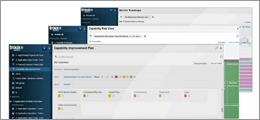
Troux’s CTO, Bill Cason, hosted a webinar that looked at capability-based investment planning. The 20-minute session reviewed how decision makers use capability modeling to better integrate business and strategic IT planning for improved operations, competitiveness and value.
The webinar and its takeaway, 6 Capability Maps Your Business Will Love, garnered a great deal of interest, so we thought we’d begin to discuss the topic on the Troux blog.
What Is Capability-Based Investment Planning?
Today, business leaders are stuck in a spin cycle of change driven by market, technology and regulatory shifts, which demand continuous planning. Capability planning supports this by delivering business leaders the enterprise intelligence they need to see the big picture and better understand where to invest in their business. Think of it as a resource management exercise – one that lets you anticipate opportunities, ensure balanced budgets and invest dollars in the right places on an ongoing basis. That might come in handy, right?
Getting Started
Use Business Capabilities to Synchronize IT with the Rest of the Business
Business capabilities can be the best starting point for your business architecture program. In the report “Business Capabilities provide the Rosetta Stone of Business-IT Alignment”, Forrester dubs business capabilities as the map to business and IT translation. Getting business and IT on the same page by adopting a common business capabilities nomenclature enables fact-based conversations about the portfolios and their alignment to the business roadmap.
Use Business Capabilities to Understand Your Critical Business Issues
The adoption of a common language supports the use of business capability maps across the enterprise. These tools facilitate transformational technology change and business change, empowering decision-making related to how the IT portfolio is deployed for the business. This means that the IT pros in the room aren’t the only ones who understand the implications of technology decisions on the business. This helps everyone see the impact and alignment of proposed IT investments or divestments on business capabilities.
Taking It to the next Level
A capability-based view of the business offers valuable insights to inform the strategic planning process. This level of enterprise intelligence assists decision-makers and strategic planners in answering critical investment planning questions such as:
- Where is the business over-invested?
- Where is the business under-invested?
- Where is the business at-risk?
- What business capabilities support corporate goals and strategies?
- What applications, technology and information support critical business capabilities?
A clear understanding of these questions enables the IT team to be proactive and focus their efforts on providing support for the applications and technology that have the most impact on the business.
Are you ready to assess your place in the capability planning continuum? Download 6 Capability Maps Your Business Will Love to review six typical strategic planning questions and how Troux answers them.





